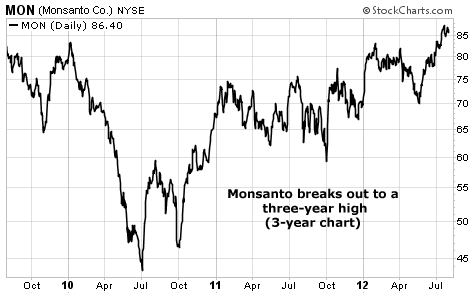| Home | About Us | Resources | Archive | Free Reports | Market Window |
You Can Still Use "Digital Utilities" to Help Pay for Your RetirementBy
Thursday, August 2, 2012
For more than 80 years, income investors have had a good friend in the utility sector.
Traditional utility stocks – like power, water, and natural gas providers – enjoy guaranteed profits.
If you want running water, cold soda in your refrigerator, or a hot stove, you have to do business with the municipal utility company. Because they enjoy legal monopoly positions, utilities accept regulations that limit their ability to raise prices. Essentially, states and towns assure themselves reliable power in exchange for guaranteeing the companies' profits.
These companies have historically been income-producing machines... Their payments were so secure and safe, bankers stuffed income-producing utilities in everyone's portfolios. They're said to be so safe, they're "fit for widows and orphans." (This is still largely true today...)
However, the modern, digital world has given rise to a new kind of utility... one that will be an even better "friend" to folks interested in generating big, safe income.
These new "utilities" supply the crucial services and infrastructure of telecommunication.
I'm talking about the companies that provide wireless services, semiconductors, software, data storage, and broadband connections. At Stansberry & Associates Investment Research, we've labeled these investments "Digital Utilities."
I first introduced this idea to DailyWealth readers last year. As I explained, two of my favorite names in this sector are Intel and Microsoft.
These two companies are still "buys" in my book, especially if you're looking for safe and growing income.
And if you're willing to try something a little different... you can double or triple the income you collect... while taking on less risk. Let me explain...
All you have to learn is a simple technique that thousands of folks are using to double, triple, and quadruple the yields they earn on stocks. You have to learn about selling "covered calls."
In general terms, selling a covered call amounts to buying shares of a stock... and then selling "call options" on that stock to other traders. Selling a "call option" gives another party the right to buy your shares from you at an agreed-upon price in the future (in this case, a higher price).
I know it might sound like a strange transaction. But it happens millions of times a day. I'll show you how it can work using Microsoft as an example...
Right now, you can buy Microsoft for about $29.40 per share. Let's say you buy 100 shares, for a total of $2,940. Right after buying your shares, you can sell someone the right to buy them from you for $30 each anytime between now and late November. You collect $110 for selling that right. This $110 payment represents an instant 3.7% yield on your shares.
If Microsoft climbs above $30 in November, you'll sell your shares for a modest capital gain... keep the instant 3.7% yield... and pocket any dividends Microsoft paid along the way.
If Microsoft does not rise to $30 per share, you simply keep that instant 3.7% yield, your 100 shares, and any dividends you collected along the way. You can then do the trade over and over again, generating a double-digit cash yield... while collecting Microsoft's safe 2.7% dividend.
Again, I believe regular shareholders of Intel and Microsoft will do just fine over the coming years. Both companies rake in huge amounts of cash and will continue to raise their dividends.
But for folks willing to do a bit more work – and learn something new – Digital Utilities present a profitable "twist" on a classic income idea... and an incredible income opportunity right now.
Here's to our health, wealth, and a great retirement,
Dr. David Eifrig
Further Reading:
Doc's readers regularly generate 10%-20% income streams by selling covered calls. "For many folks, learning this strategy is like walking out of a dark cave and into the sunlight," he says. Learn more about this unusual investment technique here.
Market NotesTHE LONG-TERM "AG" BOOM CONTINUES One of the market's biggest long-term uptrends shows no sign of stopping.
While the "official" statistics on inflation have been tame so far in 2012, they're obvious to anyone watching food prices. As "paper money," like the U.S. dollar, loses its purchasing power, prices go up for agricultural commodities like corn, soybeans, and wheat. Since the start of this year, prices for these critical crops are up between 23% and 40%.
Predicting crop prices is a tricky game. A few months of good weather, including adequate rainfall, could send prices lower. However, the one thing that is certain is that farmers will continue to plant as much as they can to take advantage of high prices.
That means steady growth for businesses like Monsanto (MON), which sells a wide range of seeds, including corn and soybeans. Monsanto is one of the top picks in Porter Stansberry's Investment Advisory.
As you can see in today's chart, Monsanto has been in a steady uptrend since late 2010. Last week, shares broke out to their highest level in more than three years. It's just the latest sign that the long-term "ag" boom deserves investors' attention.
– Larsen Kusick
 |
In The Daily Crux
Recent Articles
|


